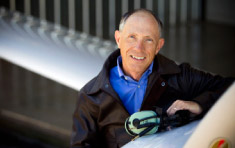 Feeling a bit rusty? Or, perhaps you’re the self-proclaimed ace of the base. How about an honest second opinion? In corporate and airline flight environments, everybody gets a going-over at least annually. For owners, this keeps the insurance company happy and skills sharp. Those who say they don’t need recurrent training often need it the most.
Feeling a bit rusty? Or, perhaps you’re the self-proclaimed ace of the base. How about an honest second opinion? In corporate and airline flight environments, everybody gets a going-over at least annually. For owners, this keeps the insurance company happy and skills sharp. Those who say they don’t need recurrent training often need it the most.
A flight review every two years—if you’re doing nothing else—results in a dry spell between practice sessions. Routine cross-country trips are pretty basic for pilots who fly regularly—we don’t see many DME arcs, engine/electrical failures, or manual landing gear extensions (thank goodness)—so organized exercise reviews are an excellent idea.
Practicing what I preach, this year my session took place at SimCom in Orlando, Florida, and included time in a Beechcraft Bonanza flight training device. Here, new Bo pilots take a three-day initial course and, for everyone else, there’s a one-day recurrent course.
Courses largely are taught one on one, tailored to your particular need. The training center houses classrooms and training devices/simulators for Cessna Citations, Beechcraft King Airs, Mitsubishi MU–2s, all manner of Piper singles, Socata TBMs, and Pilatuses—so you’re as likely to meet an owner as a professional in the break room. Owner pilots have diverse flight backgrounds: A few are as good as any pro, some are lucky to be alive, and most of us fall somewhere in the middle. The instructors are there to teach and counsel, and to improve skills, no matter what the pilot brings to the party. If someone is in dire straits, additional training will be recommended.
Bonanza systems are fairly simple. We briefly touched on potential trouble spots but didn’t get mired in the minutia. SimCom provides a nice reference manual that expands on the POH and covers much of the same information—but in a more readable format. The performance numbers on all light aircraft are engineering fact and, largely, operational fiction. Your real-world numbers will vary, so don’t take it to the limit.
Beech revised the A36 panel in 1984 to match the industry-standard layout of gear, flap, prop, throttle, and mixture controls. The Frasca device exactly replicates this. Pilots of older A36s or short-body Bonanzas will need some modest accommodation to adapt. Having flown both aircraft, it’s not a big deal, but don’t confuse gear and flap switches! The machine has nice handling characteristics, and typical of most training devices, good pitch control requires an active scan. In hand-flying part of the way home, my control smoothness had markedly improved. Minor ego deflation in training seems to pay off nicely in the aircraft.
Flight instruments are typical Bonanza. A 220-degree daylight visual display allows a good view of the traffic pattern and great realism for the inevitable engine failure shortly after takeoff. Remember to lower the nose and go to High on the aux fuel pump immediately if the engine quits with no warning or vibration. I didn’t, but the gear was still down on a long runway, so the red crash screen didn’t appear. On a short runway, I’d have been in the weeds.
I practiced manual gear extension several times—first in visual conditions and then under instruments. Use the autopilot if there’s not a total electrical system failure—which, of course, was one of my misfortunes. Depart the traffic pattern and remember to fly the aircraft first, even when slaving over a hot hand crank.
Arriving at Daytona Beach in a simulated snowstorm (there can be some strange weather in training), the pitot-static system froze up, making for some unusual altimeter and airspeed indications. I never had that happen in real life, but Northwest Airlines lost a Boeing 727 in the 1970s because of this. I had to find the alternate static source under the panel, and while I didn’t hit the ground, it was close enough. Good practice!
There are enough instrument approaches in a typical course to provide IFR currency, as long as you’re not outside the 12-month window as specified in FAR 61.57(d). Beyond that, a flight in an aircraft is required, which can be arranged. Pilots with an FAA Wings account can get credit for a flight review without flying.
Corporate aviation’s superb safety record comes about because of consistently high proficiency levels. In personal flying, many pilots who cannot rack up high annual flight hours save some dollars for periodic training. SimCom’s “express” one-day recurrent course is offered for an introductory price of $960, which includes four hours of ground school and four in the sim. It’s valuable to experience scenarios not seen in the real world. Family members or friends can go see Disney while you get your own ride in the magic kingdom. Both experiences will be memorable.
Bruce Landsberg is the former president of the AOPA Foundation and is a senior safety advisor to the AOPA Air Safety Institute.



